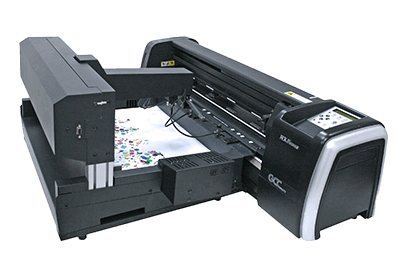What Is a Cutting Plotter?

A cutting plotter is a machine that cuts sheet materials.
It uses the line data drawn by draw-type software (drawing-type software) as a cutting path and cuts along the data. It is also used for half-cutting applications.
A sheet of sticker material can be used to create a sticker or sticker of any shape by cutting it in half. Depending on the model, in addition to cutting and half-cutting, it is also possible to crease the paper or perforate the paper.
Some models can read lines or pictures on paper with a scanner and automatically generate cut paths from them for easy editing.
Uses of Cutting Plotters
Cutting plotters are used for signage applications such as billboards and posters, as well as for cutting out pop-ups for in-store use. Sheets for stickers with release paper attached can also be used for semi-extraction to cut out sticker shapes.
While cutting plotters can cut out any shape, their processing speed is not fast, making them unsuitable for mass production. In the apparel industry, during the development stage, each part of a garment is sometimes cut out of paper using cutting plotters, and there is a growing trend of using cutting plotters with special specifications.
Many models combine an inkjet printer with cutting plotters. Rolled media is set, printing is performed, and the cutting process is carried out downstream. This is extremely efficient as it allows both printing and cutting to be done in a single operation.
Since cutting plotters can also cut fabric materials, they are also used for cutting out garments.
Principle of Cutting Plotters
Cutting materials can be cut into the desired shapes by pressing the blade against the material and moving either the blade or the material.
In addition, to cut a material cleanly, the blade material, the strength and speed of the blade press, and the speed of movement must be appropriate for each material. Since blades are used to cut out materials, blades are consumables and need to be replaced periodically. The mat that serves as a support for the blade also wears out at the same time and affects quality, so it needs to be replaced as well.
Types of Cutting Plotters
Cutting plotters can be broadly classified into two types: one type is called the grid rolling type, in which the blade moves only in the X direction and the material to be cut is conveyed in the Y direction.
The other type is a fixed material type, where the cutter moves in both the X and Y directions. This type is called the table type or flatbed type.
1. Grid Rolling Type
In the grid rolling type, the blade moves left and right while the material to be cut moves back and forth during cutting. The feature of this type is that the equipment can be downsized, and there are many small tabletop machines available.
When cutting with this type, the material must be attached to a special adhesive mat. This is because cutting is performed while feeding the material back and forth, and if the material is separated from the mat, it cannot be transported. Materials used for cutting are often set in a rolled state, and despite their small size, they can cut out long materials at a time.
2. Table Type
Table-type cutting plotters have numerous small holes in the table, and a vacuum fan or a similar device is used to adsorb and secure the material. The cutter moves in the X-Y direction to process the desired shape.
There are further types of table-type cutting plotters for commercial and industrial applications. There are many tools, such as stretching tools for creasing paper, tools for laser cutting, and tools for cutting thicker materials by vibrating the blade. Compared to the grid rolling type, they can cut through thicker materials but tend to take longer to work with.